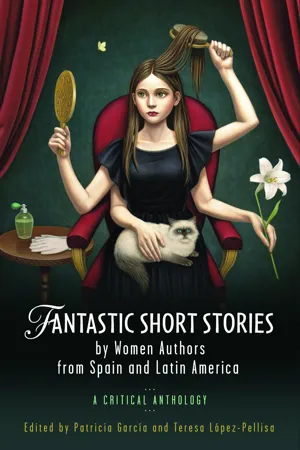![]()
Notes
The Fantastic: Towards a Feminist Perspective
1. Ernst Theodor Amadeus Hoffmann (1776–1822) was a German writer and composer associated with Romanticism. Among his fantastic works are Fantasiestücke (1814), The Devil’s Elixirs (1815) and Nachtstücke (1817). The latter volume contains his well-known story ‘The Sandman’, used by Freud as a basis for his essay Das Unheimliche (1919).
2. ‘The person who experiences the event must opt for one of two possible solutions: either he is a victim of an illusion of the senses, of a product of the imagination – and laws of the world remain what they are; or else the event has indeed taken place, it is an integral part of reality – but then this reality is controlled by forces unknown to us. The fantastic occupies the duration of this uncertainty’ (Todorov, 1975: 25).
3. These two authors are the main referents of fantastic literature written in Spanish. Borges (1899–1986) wrote a large number of fantastic fictions, collected in volumes such as Ficciones (1944), El Aleph (1949) and El libro de arena (1975). Cortázar’s (1914–84) most famous stories, like ‘Casa tomada’, ‘Continuidad de los parques’ and ‘Axolotl’ can be found in Bestiario (1951) and Final del juego (1956).
4. One of the most scandalous examples of this is the publication by Dárcena in 2016 of Reencuentro de personajes, by the Mexican writer Elena Garro. Assuming that Garro would not be known to the readership, the publisher initially promoted her in terms of her relationships with other Latin American male writers: ‘Mujer de Octavio Paz, amante de Bioy Casares, inspiradora de García Márquez y admirada por Borges’.
5. These four English authors are pioneers of the Gothic novel. Walpole (1717–97) is well known for building the eccentric Strawberry Hill House, a villa that became a reference for the revival of Gothic architecture. His novel The Castle of Otranto is regarded as one of the initiators of the Gothic movement in the second half of the eighteenth century. Reeve (1729–1807), Lee (1750–1824) and in particular Radcliffe (1764–1823) also wrote influential Gothic novels, such as The Old English Baron (Reeve, 1777), The Recess (Lee, 1783–5) and The Mysteries of Udolpho (Radcliffe, 1794).
6. In the past few decades, several scholars have provided illuminating readings of the sublime, emphasising the differently gendered connotations of the aesthetic category of ‘beauty’ versus that of ‘the sublime’. Philip Shaw declares: ‘With its ideological stress on sociability and the domestic affections, and its stylistic emphasis on the fleeting, the fanciful, and the pathetic, the beautiful was regarded as secondary to the “manly” vigour and the complexity of the sublime. Too sensual to overcome the bonds of nature, too weak to sustain visionary flight, women were seen as unfit subjects for the trials of the sublime’ (2006: 106). On this subject, see the aforementioned Gothic and Gender (Heiland, 2004), as well as Shaw’s section ‘Feminine Difference’ in The Sublime (2006: 105–13), Christine Battersby’s study Gender and Genius (1989), Anne K. Mellor’s Romanticism and Gender (1993) and Catherine Maxwell’s The Female Sublime from Milton to Swinburne (2001).
7. Mary W. Shelley (1797–1851), daughter of feminist activist and intellectual Mary Wollstonecraft, remains one of the most famous female novelists of the fantastic with her work Frankenstein; or, The Modern Prometheus.
8. Bram Stoker (1847–1912) was an Irish author best known for his horror novel Dracula, which immortalised the character of Count Dracula in the history of vampires in literature and later in cinema. For an interesting typology of vampires in the nineteenth century, see Christopher Frayling’s Vampyres: Lord Byron to Count Dracula (1991).
9. E. A. Poe (1809–49) is one of the fathers of the modern fantastic. He is best known for his short stories, which have been foundational works on the aesthetics of the macabre and but also for providing an innovative psychological dimension to the fantastic, exploring the fringes of sanity and madness. Among his famous fantastic short stories are ‘The Fall of the House of Usher’ (1839), ‘The Oval Portrait’ (1842), ‘The Pit and the Pendulum’ (1842) and the aforementioned ‘The Black Cat’ (1843). He also popularised detective fiction in his tales featuring Auguste Dupin, and wrote influential essays on literary theory, such as The Philosophy of Composition, still considered one of the first essays to theorise the short story as a genre.
10. Maupassant (1850–93) is as acclaimed for his fantastic short stories as he is for his realist novels (for example Bel Ami, 1885). It is in his short story production that we find precious examples of the late nineteenth-century fantastic, with influential pieces such as ‘Le Horla’ (1886, 1887) and ‘Qui Sait?’ (1890). He made of the psychological a defining feature of his fantastic narratives, frequently featuring characters who are mentally deranged and thus whose account of th...
